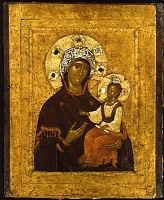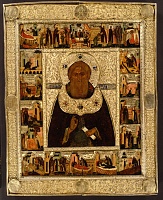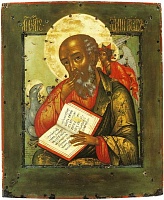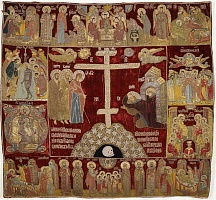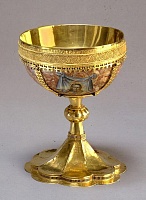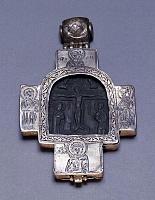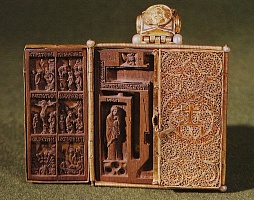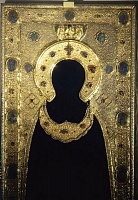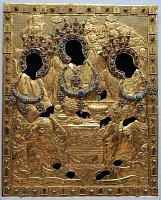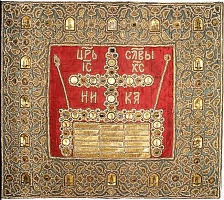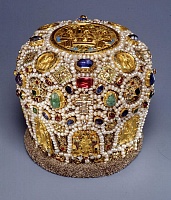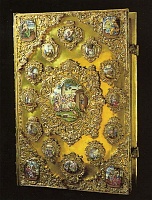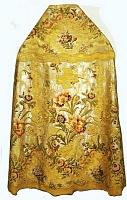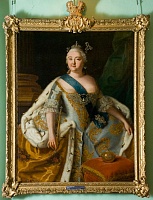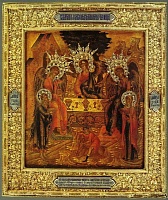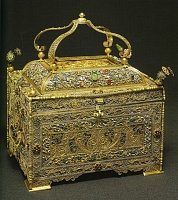Exposition: The Sacristy of the Trinity-St. Sergius Lavra of the 11th - 17th cc.
The exhibition is open to single visitors (from 1 to 15 people) and for combined groups with guided tours (from 5 to 11 people) for a session.
Session duration - 45 minutes
Wednesday – Sunday from 10.00 to 18.00.
self-guided sessions: 10.00/ 10.30/ 11.15/ 12.00/ 14.00/ 14.30/ 15.15/ 16.30/ 16.45
guided tour sessions: 10.15/ 10.45/ 14.15/ 14.45/ 16.00
The Sacristy of the Trinity-St. Sergius Lavra of the 14th - 19th cc.
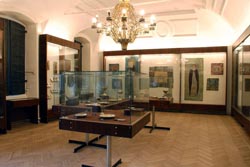 The exhibition presents the collection, which was historically formed in the Trinity-St. Sergius Lavra in the 14th – 19th cc. The collection is housed in the Monastery Sacristy and the Vicegerent Chambers, situated at their historical place within the walls of the Monastery. The collection comprises rare and unique monuments: icons, manuscripts and old printed books, icon and ornamental embroideries, items of gold and silver. They were donated by grand and appanage princes, tsars and emperors, noblemen and representatives of different layers of the society
The exhibition presents the collection, which was historically formed in the Trinity-St. Sergius Lavra in the 14th – 19th cc. The collection is housed in the Monastery Sacristy and the Vicegerent Chambers, situated at their historical place within the walls of the Monastery. The collection comprises rare and unique monuments: icons, manuscripts and old printed books, icon and ornamental embroideries, items of gold and silver. They were donated by grand and appanage princes, tsars and emperors, noblemen and representatives of different layers of the society
The separate hall on the ground floor houses the collection of Old Russian fine art represented by outstanding specimens of icon-painting and miniature book illuminations. The Royal Doors were painted by the artists from the team of Andrei Rublev who was invited to decorate the Trinity Cathedral in the 1420s. “The Virgin Perevleptos” and “Anna with the Child Mary” are rare monuments of the 14th century Byzantine and South-Slav monuments. The Museum collection presents the main iconographies of the Virgin: Hodigitria, Eleousa, the Virgin of the Sign - and their numerous variants: the Virgin of Vladimir, the Virgin of the Don, the Virgin Bogolubskaya, the Virgin of Tikhvin, the Virgin of Jerusalem, the Virgin Grebenskaya, the Virgin of Yakhroma, the Virgin of Kazan, the Petrovskaya Virgin, the Pimenovskaya Virgin, etc. These icons reflect an extraordinary popularity of the Virgin in Moscow Rus.
The Monuments from the icon-painting workshop of the Trinity Monastery occupy a important part in the Museum collection. The icons with the signature of the Monastery Cellarer Eustathius Golovkin, painted at the end of the 16th century on the boards of Venerable Sergius’s shrine, are referred to outstanding works.
The exhibition presents various icon-painting schools of the 17th century. There are remarkable works of Godunov and Stroganov workshops, and the Armory Chamber. There are also works of an outstanding artist of the Armory Chamber of the Moscow Kremlin Simon Ushakov. He painted icons for the Trinity and Assumption Cathedrals in the Monastery in the 1680s.
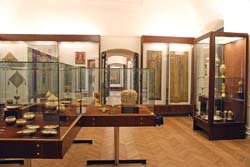 On the second floor of the Sacristy there is a part of the exposition demonstrating applied and decorative art of Old Russia. The exhibits were generally used for the church services in the Trinity St. Sergius Monastery. Made by gold- and silversmiths, Some embroideries preserved historical inscriptions, recording memorable and sometimes dramatic events of their time. The icon-cloth “The Appearance of the Virgin to St. Sergius” reflected the tragic destiny of Grand Princess Solomonia Saburova, the first wife of Vassili III. The icon-cloth, embroidered in multicolored silks, pearls, gold and silver threads, was presented to the Trinity-St. Sergius Monastery in 1525 with a prayer for a son: “… may the Almighty God beget them with a child….”carvers and needlewomen, they demonstrate aesthetic ideas of their time.
On the second floor of the Sacristy there is a part of the exposition demonstrating applied and decorative art of Old Russia. The exhibits were generally used for the church services in the Trinity St. Sergius Monastery. Made by gold- and silversmiths, Some embroideries preserved historical inscriptions, recording memorable and sometimes dramatic events of their time. The icon-cloth “The Appearance of the Virgin to St. Sergius” reflected the tragic destiny of Grand Princess Solomonia Saburova, the first wife of Vassili III. The icon-cloth, embroidered in multicolored silks, pearls, gold and silver threads, was presented to the Trinity-St. Sergius Monastery in 1525 with a prayer for a son: “… may the Almighty God beget them with a child….”carvers and needlewomen, they demonstrate aesthetic ideas of their time.
The aesthetic ideas of that time were also revealed in various works of gold- and silversmiths. The earliest works, dating back to the 14th and 15th century, are marked by a simple decoration corresponding to the tastes of that time. The signed silver reliquary cross with engraving and a stone relief icon, made by Semyon Zolotilov, was presumably commissioned by Prince Dmitry Ivanovich (Donskoi). The gold chalice with magnificent filigree on the rim of the bowl, presented to the Trinity-St. Sergius Monastery by Grand Prince Vassili II in 1449, is a masterpiece of jewelry art. On the bottom the rare inscription with the name of the craftsman runs: “And made by Ivan Fomin”.
The workshop of the Trinity-St. Sergius Monastery is represented by works of an outstanding carver and jeweler of the mid-15th century Ambrose. His works are marked by a perfect composition, intricate carving, picturesque ornamental pattern. The folding icon of walnut in a gold filigree mounting, commissioned by the Monastery Hegumen Vassian Rulo, is an outstanding monument of that period.
In the 16th century, Ivan the Terrible presented quite a complex of wonderful monuments. That was the time when Moscow became an All Russia cultural center and jewelry art flourished there. The best works were created by the artists of the Moscow Armory Chamber and the Trinity-St. Sergius Monastery. The bright specimens of that epoch are gold crowns and crescent collars with pendants, presented by Ivan the Terrible for “The Trinity of Old Testament” painted by Andrei Rublev. Their shape is simple, yet refined. Their decoration, combining skilful chasing, filigree and grains on gold with multicolored enamel and precious stones, is very fine. The gold mounting for the icon “St. Sergius”, made by 14 craftsmen of the Armory Chamber in the second half of the 16th century, is a remarkable work of Moscow goldsmiths.
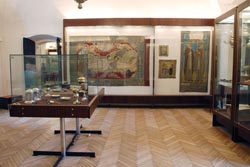 Jewelry art influenced the development of icon-embroidery. Items, embroidered in the royal workshops, were decorated with pearls, precious stones, gold and silver threads. The embroidered items, produced by the workshop of Princes Staritsky, are characterized by superb technique, elaborate composition and bright color-scheme. The best traditions of Ivan the Terrible’s time were kept and developed at the epoch of Boris Godunov. The documents recorded several special occasions of the tsar’s visit to the Monastery. Those visits were accompanied by generous donations. That period is represented in a separate hall.
Jewelry art influenced the development of icon-embroidery. Items, embroidered in the royal workshops, were decorated with pearls, precious stones, gold and silver threads. The embroidered items, produced by the workshop of Princes Staritsky, are characterized by superb technique, elaborate composition and bright color-scheme. The best traditions of Ivan the Terrible’s time were kept and developed at the epoch of Boris Godunov. The documents recorded several special occasions of the tsar’s visit to the Monastery. Those visits were accompanied by generous donations. That period is represented in a separate hall.
Godunov’s jewelers were famous for niello on gold, which was especially brilliant on the set of liturgical vessels displayed in the Museum. Niello was used together with other techniques in decoration of the mounting for the icon “The Trinity of Old Testament” painted by Andrei Rublev. The main parts of the mounting were made by the order of Boris Godunov. Subsequently they were supplemented with other details. In 1602 – 1603, Boris Godunov “ gave an Archimandrite cap as a donation” . That was the mitre with a gold crown, gold plaques, pearls and precious stones – amethysts, emeralds, sapphires.
Тhere were talented needlewomen and artists in Boris Godunov’s workshops. The purificator showing the Trinity and the frontal “The Queen did stand” are marked by luxury, decorativeness and high technical skill. “The Pearl Icon-Cloth” of 1599 is a masterpiece of ornamental embroidery. It is decorated with pearls, gold plaques and red, blue and green precious stones.
The works of the 17th century gold- and silversmiths are varied in materials and techniques. They are decorated with enamel, chasing, precious stones. The mitre of Princes Mstislavsky, presented to the Monastery in 1626, is a characteristic specimen of that period. All decorative details, outlined in pearls and perfectly assembled, look extraordinary beautiful and luxury. Fine engraving and niello decorate the gold crosses. One of them was presented by Irina, the daughter of Tsar Mikhail Feodorovich. The other was donated by the relatives of the Duma Deacon Ivan Gramotin. The cross, produced by Andrei Malov is exceptionally beautiful..
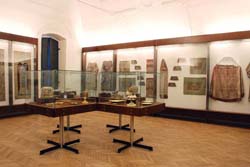 The 17th century embroidery is remarkable for accentuated decorativeness, skilful and varied stitching. The Pall “St. Savva Storozhevsky” is characteristic. It’s background imitates precious textile – brocaded silk . The most refine embroidery marks the works produced in Stroganov’s workshops. Ornamental embroidery is represented by diverse samples. The splendid epitrachelion of red velvet is embroidered in pearls supplemented with gold plaques, small garnets and turquoise
The 17th century embroidery is remarkable for accentuated decorativeness, skilful and varied stitching. The Pall “St. Savva Storozhevsky” is characteristic. It’s background imitates precious textile – brocaded silk . The most refine embroidery marks the works produced in Stroganov’s workshops. Ornamental embroidery is represented by diverse samples. The splendid epitrachelion of red velvet is embroidered in pearls supplemented with gold plaques, small garnets and turquoise
The part of the exposition, dedicated to the Synod period (1721 – 1918), is housed in the Vicegerent Chambers conned with the Sacristy by a passage. At that time the Monastery Cathedrals, Sacristy and new palaces and residences were decorated according to the contemporary fashion and taste. The prevailing decorative monuments were icons, icon and ornamental embroideries, books, church objects of precious metals. The most remarkable monument is the set of church vestments embroidered in pearls. “The Pearl Sacristy” was commissioned by Catherine II and made to the order of the Trinity Archimandrite Platon Levshin. They used the old Monastery pearls from ancient icon-cloths. The frontal “The Cross on Golgotha” for the Trinity Cathedral and the shroud “The Entombment”, made to Platon Levshin’s order, are fine works of the late 18th century art.
The patterns of pearl embroidery on the shoulder-pieces of the church vestments look like stucco molding according to the new tendencies of that time. The luxurious church vestments of velvet and brocade present fine samples Russian precious textiles that were as artistic as European fabrics.
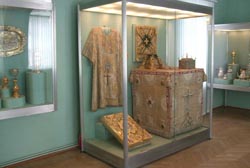 The collection includes a lot of works of Moscow and St. Petersburg silversmiths of the 18th – 19th century. They achieved success in different jewelry art techniques: chasing, niello, enamel, etc. Chasing was a preferable technique. Its patterns were considerably changed. They were composed of large baroque scrolls, shells, baskets with flowers and fruit made in high relief. The mounting for the Gospel of 1754 is decorated with intricate chased pattern, which is harmoniously supplemented with enamel plaques with fine miniatures. The 18th filigree patterns differ from the patterns of the previous epoch. They are more complicated. The ornaments are used in many layers and combined with enamel and precious stones. The reliquary of 1789, which once belonged to Metropolitan Platon, is a unique specimen of that time. Its shape and refine decoration make it look like a precious casket.
The collection includes a lot of works of Moscow and St. Petersburg silversmiths of the 18th – 19th century. They achieved success in different jewelry art techniques: chasing, niello, enamel, etc. Chasing was a preferable technique. Its patterns were considerably changed. They were composed of large baroque scrolls, shells, baskets with flowers and fruit made in high relief. The mounting for the Gospel of 1754 is decorated with intricate chased pattern, which is harmoniously supplemented with enamel plaques with fine miniatures. The 18th filigree patterns differ from the patterns of the previous epoch. They are more complicated. The ornaments are used in many layers and combined with enamel and precious stones. The reliquary of 1789, which once belonged to Metropolitan Platon, is a unique specimen of that time. Its shape and refine decoration make it look like a precious casket.
Alongside with church utensils, commissioned by the Monastery authorities, there are paintings, pieces of furniture, lamps, objects of everyday life from the living chambers of the Lavra clergy. Ivan Nikitin, an outstanding artist, a founder of Russian realistic portrait painting, is considered to be the author of the portrait of Tsarina Praskovia Feodorovna Saltykova, the wife of Peter the Great’s brother - Ivan Alexeyevich. The portraits of Elizaveta Petrovna and Peter III were painted by Alexei Antropov, a brilliant representative of the baroque period. At that time gala portraits were very popular. Their main task was to demonstrate the position of the portrayed in the society.
The items of the New Time collection show a logical development of the medieval complex which was historically formed in the Monastery. “The Sacristy of the Trinity-St. Sergius Lavra of the 14th – 19th cc.” of the Sergiev Posad Museum-Reserve, presenting the first-rate works of art, gives a vivid idea of Russian artistic life in the course of several centuries.









